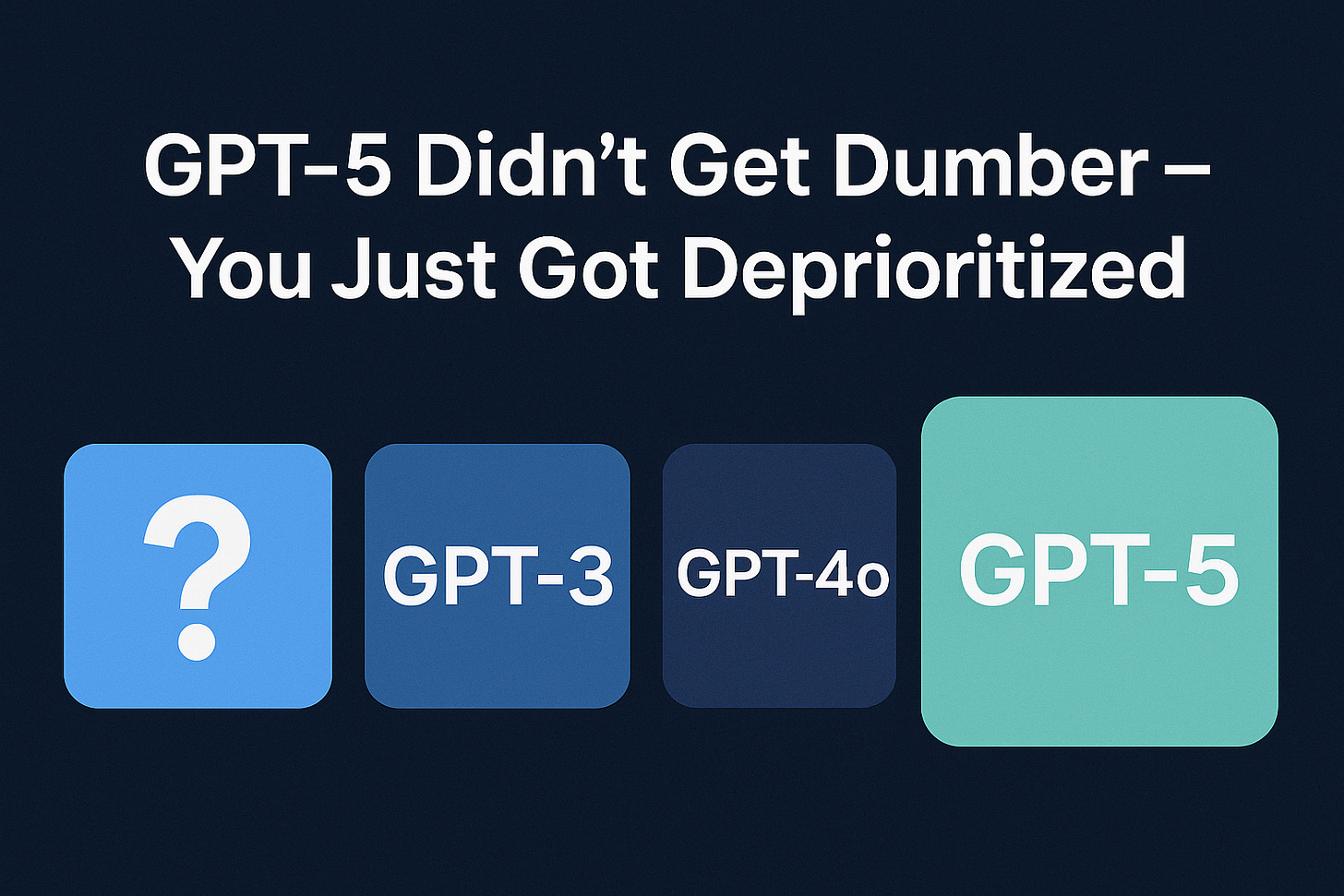GPT-5 Didn’t Get Dumber — You Just Got Deprioritized
Thousands of users on Reddit and X have been calling GPT-5 “dumber,” colder, and emotionally detached. Some even claimed it’s the worst update yet.
But GPT-5 didn’t get worse. It simply stopped trying to please you.
This is a strategic pivot with both ecosystem and business implications:
OpenAI is no longer positioning itself as an emotional companion for end users — it’s doubling down on becoming infrastructure for developers.
1. For everyday users: The experience feels colder — but it’s not about intelligence loss
GPT-5 now speaks in a more neutral, rational tone. Gone are the clickbait-style responses, the punchy affirmations, the emotional hand-holding.
There’s less theatrical drama, fewer dopamine-triggering one-liners — and more dry, structured reasoning.
If it feels "dumber," that’s not because the model got worse.
It’s because you are no longer its primary optimization goal.
OpenAI has effectively pulled back from crafting a “RedNote-style” emotional dialogue engine. It’s no longer tuning for human warmth or viral voice — and is instead leaving that responsibility to app builders.
That said, GPT-5 does come with meaningful upgrades for power users:
First, seamless multimodal integration. You no longer have to manually switch modes to generate images — visual and textual inputs are handled in a single unified flow, making the user experience smoother and more intuitive.
Second, significantly improved context handling and memory retention. In my own tests involving complex company staff data — with unique, high-precision profiles for each individual — GPT-5 was able to maintain coherence and recall across more than 50 messages over two days, without needing to be reminded who was who.
So yes, it may feel colder. But under the hood, it’s more capable than ever.
2. For developers: More powerful tools, more room to build
As someone without technical background, most of what I’ve come to understand about GPT-5’s architecture comes from OpenAI’s developer documentation, the official system card, and insights shared by researchers in the field.
First, the API is significantly more capable.
Clearer documentation, more intuitive parameter semantics, faster and more stable function calls — the overall developer experience feels like a generational leap forward.
Second, the cost-performance ratio has improved dramatically.
Thanks to finer-grained pricing and flexible inference options, developers can now run far more exploratory or compute-heavy tasks without worrying about budget burn.
This unlocks:
More advanced caching and compression strategies
Long-context conversations and multi-agent loops
Large-scale inference experiments without cost blowouts
In short, building intelligent, agentic systems is no longer reserved for well-funded teams — the playing field is flattening fast. (Ref: Hance @ MyShell blog)
What’s particularly fascinating is this: GPT-5 isn’t a single model. It functions more like a modular response system, where a router dynamically selects between multiple sub-models (like “main” and “thinking” modes, reportedly corresponding to GPT-4o and GPT-3o variants), depending on the type and complexity of the user’s input.
This architecture points to a deeper shift: OpenAI is no longer just shipping “models” — it’s building orchestrated systems that adapt based on context and intent.
Add to that other signals like:
Cursor’s founder confirming GPT-5 as their default model, and
OpenAI’s increasing emphasis on verifiable, domain-specific benchmarks like HealthBench —
and a pattern emerges: GPT-5 is being positioned not just as a chatbot engine, but as a core platform for scientific, reliable, and vertical AI applications.
3. For emotional-AI product builders: A golden window to leap ahead
In the past, GPT-4 showed unexpected talent as an emotional companion — it could “listen,” offer encouragement, and even feel eerily present. But OpenAI has made it clear: that’s not the road it wants to own.
Emotional AI is compute-intensive, hard to monetize, and full of ethical landmines.
So OpenAI is stepping back.
And that opens the door wide for startups to step in.
Here’s why this moment matters:
User demand is real and rising, especially among Gen Z users in Asia, who increasingly turn to GPT not just for answers, but for emotional support.
Many have developed their own ways of using GPT as a confidant, a late-night therapist, or even a pseudo-friend.
This also explains the outcry on Reddit and X after GPT-5’s release, where users accused the model of being “dehumanized” — stripped of empathy, softness, and its once-relatable tone.The capability is already proven — The capability is already proven — emotional AI is not a theory, it’s a working prototype.
That said, much of GPT-4’s success in this area stems from its position as the world’s most advanced model — with built-in trust and a massive user base.
For startups trying to replicate that kind of emotional resonance, trust becomes the first hurdle.
But that also opens a path: by prioritizing user rights, privacy, and scientific grounding, startups may be able to offer something OpenAI doesn’t — emotional AI that feels both personal and principled.You don’t need to train a model — all you need is to design the right UX, prompts, and emotional scaffolding on top of OpenAI’s infrastructure.
Closing Thoughts
OpenAI has stopped trying to win your heart — but you can build an AI that still does.
This strategic shift isn’t just a loss in user experience.
It’s an open invitation for builders to own the next layer of emotional, human-centered AI.
Don't just look at what GPT-5 took away.
Look at what it just made room for.

